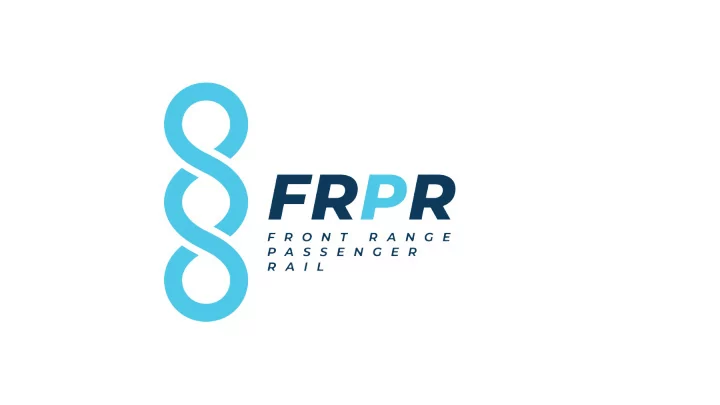

Rail Commission: Initial Modeling Results August 28th, 2020
Welcome
BNSF Route
Big Takeaway: Model Projects a Notable Demand for Rail After months of data-intensive work and many simulated runs, we found: o There would be demand for rail service along the Front Range. o Demand is highest for commuters, but there’s also substantial demand for recreation and special events. o Front Range Passenger Rail ridership projections fare well when compared to other successful intercity rail lines across the country. o There would be real reductions in emissions and vehicle miles traveled.
Project Development: Schedule WE ARE HERE STEP 1 STEP 2 STEP 3 STEP 4 LEVEL 1 PROJECT LEVEL 2 ADVANCE EVALUATION INITIATION & EVALUATION TO NEPA SCOPING What are the How do alternatives Federally required compare? process to advance possibilities for What do we want major infrastructure Front Range corridors and projects Passenger Rail to operations? be? STAKEHOLDER ENGAGEMENT AND GOVERNANCE
Where are we in the modeling process? Roughly halfway done. Future model runs will consider: o We are looking at additional development around stations (TOD) o Fewer trains (More limited service scenarios) o Different sets of stations o BNSF + N Line (FASTRACKS) Alignment with 125 mph technology o I-25 + E-470 Alignment with 125 mph technology
CDOT Model Uses the Highest Scientific Standards ▪ “Behavioral” o Survey data on people and their travel o “Revealed preference”: not “what would you do?” but “what did you do?” ▪ Detailed o Each person modeled individually o Each house and business located at its address o High level of realism in the model ▪ Checked and double-checked o U.S. Census data, vehicle and transit ridership counts, compare to “big data” sources
CDOT’s Model Is Better Than Most States’ ▪ One of the most advanced state-level models in the US o “ Activity-based” models are now common in large metro areas o Now starting to be used at state level ▪ Part of a long practice of travel modeling in the U.S and around the world o Earliest such models date to the 1960s o CDOT’s model is a “next-generation” model o Represents best practice in the field ▪ Adapted DRCOG’s model for state use o DRCOG has used their model for 10 years
Model Uses Specific Speeds and Geographic Details ▪ Stay with existing transportation corridors and past studies ▪ Engineering o Horizontal & Vertical Alignments • Avoid sharp curves & steep grades to meet railroad design standards • Minimize right-of-way and environmental impacts, excessive cut and fill o Speeds • Assume higher speed capability (90-125 mph maximum) • Use appropriate operations in urban vs. rural areas • Factor in climbing and reducing speeds for stations ▪ Potential Markets and Station Locations o Identified in the planning process o Modeling tests different scenarios ▪ Other - $2 parking cost, 32 cents/mile fare
Results Show BNSF Alternative (through Boulder/Longmont) Produces High Ridership (In each direction)
BNSF Alternative Compares Favorably to Peers (In each direction)
Usage Projected Highest in the Northern Segment
Other Modeling Outputs: Demand for Special Events and Emission Reductions “ Special” trips (weekends, stadium events, etc.) - About 20% of yearly boardings Greenhouse Gas reduction - About 210,000 vehicle miles traveled (VMT) saved per typical weekday - 411 grams per mile for a typical car (EPA figure) - Means 94 tons saved per typical weekday
Where will the trips begin and end? Most trips would be within MPO areas. For context, this table shows actual total person trips (all modes) along the Front Range, both inter and intra-regional.
Strongest Demand Would Be for Commuting
Points in Closing ▪ Speed matters, but urban operation and some rural grades limit how fast we can go ▪ Connectivity and schedule can have an impact • because out-of-vehicle time is disliked more than in-vehicle time ▪ FRPR ridership much higher for a Denver Union Station stop versus Burnham Yard ▪ Few end-to-end trips by any mode • 2010 FRTC survey, Streetlight Data and Census Journey-to-Work all agree closely on this • Model results match all three data sets
Thank you! Erik E. Sabina, P.E. Manager, Information Management Branch Erik.Sabina@state.co.us 303-757-9811
Recommend
More recommend